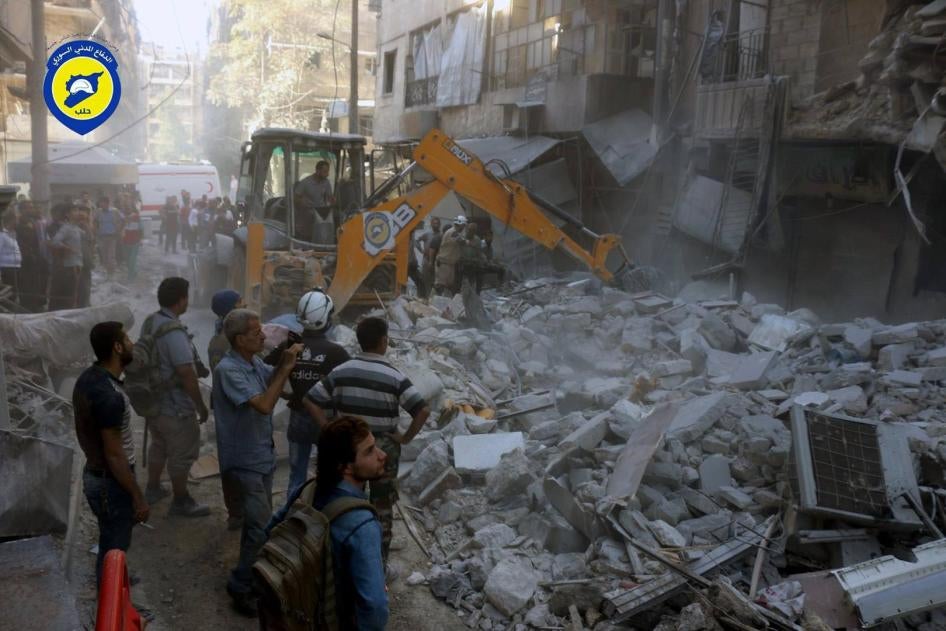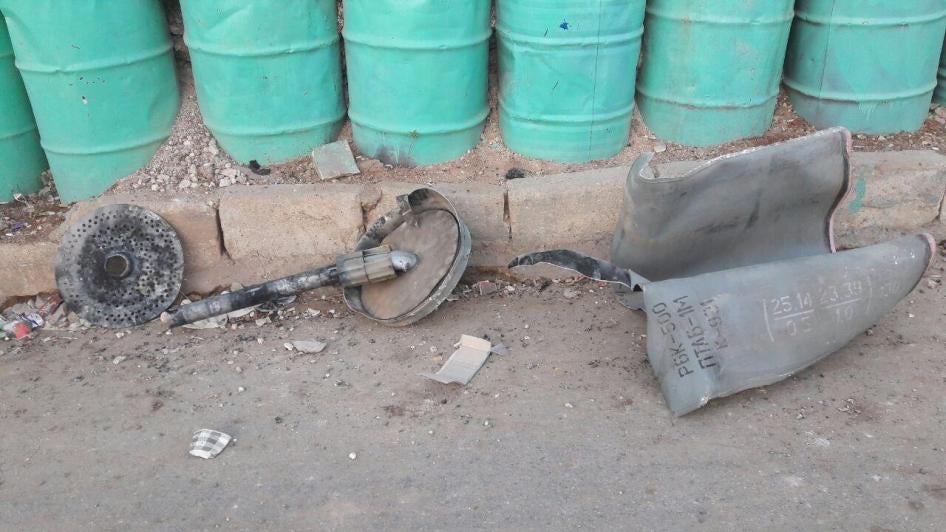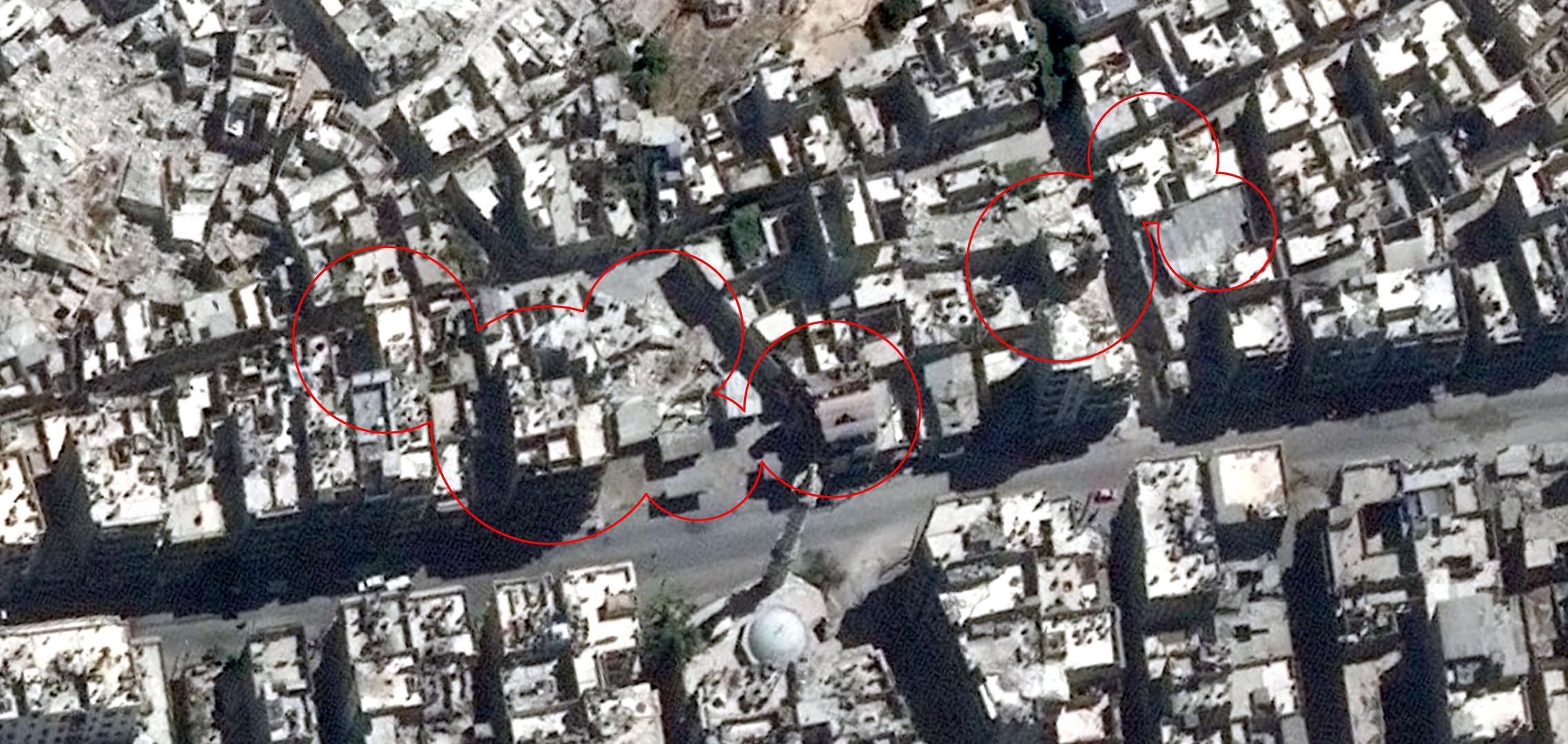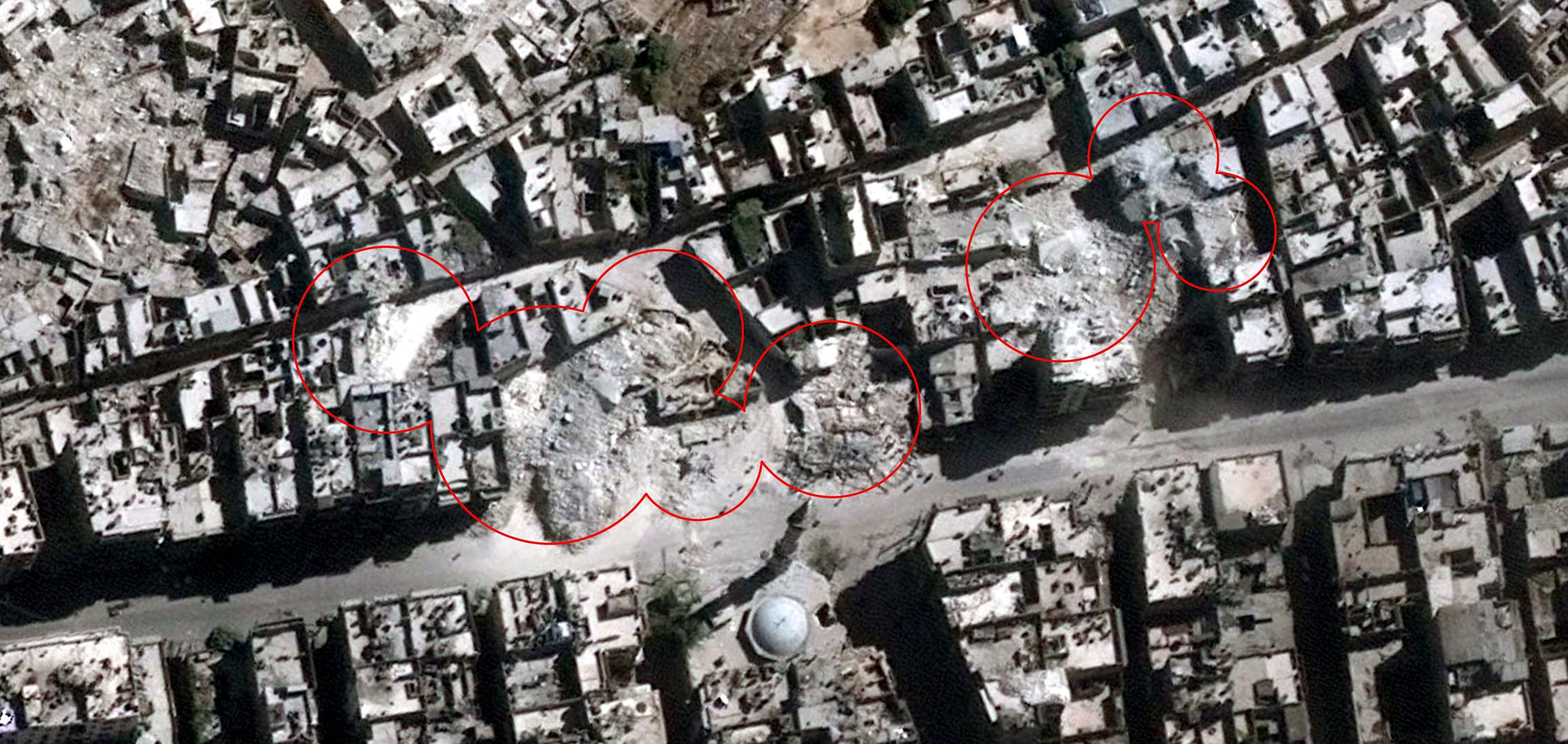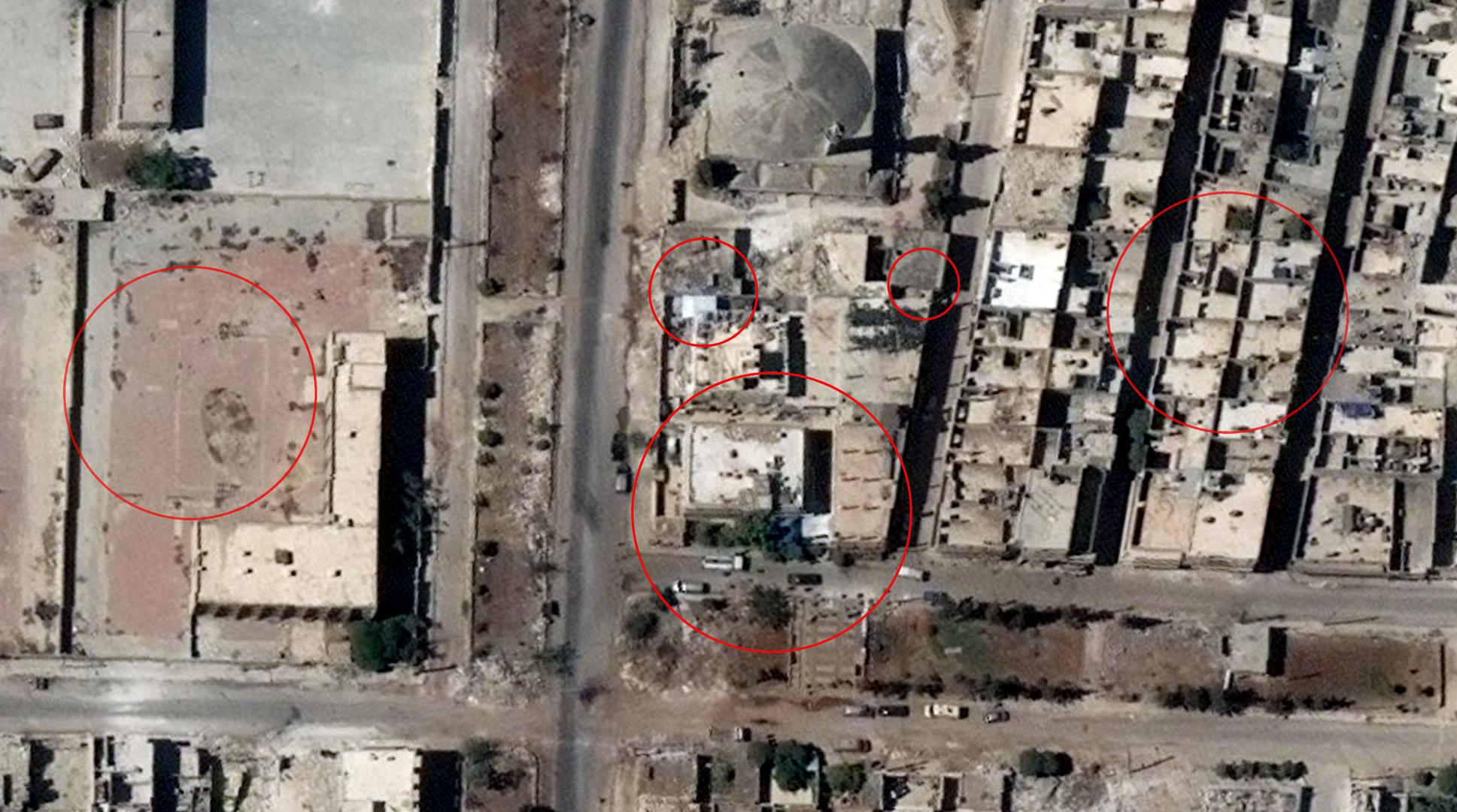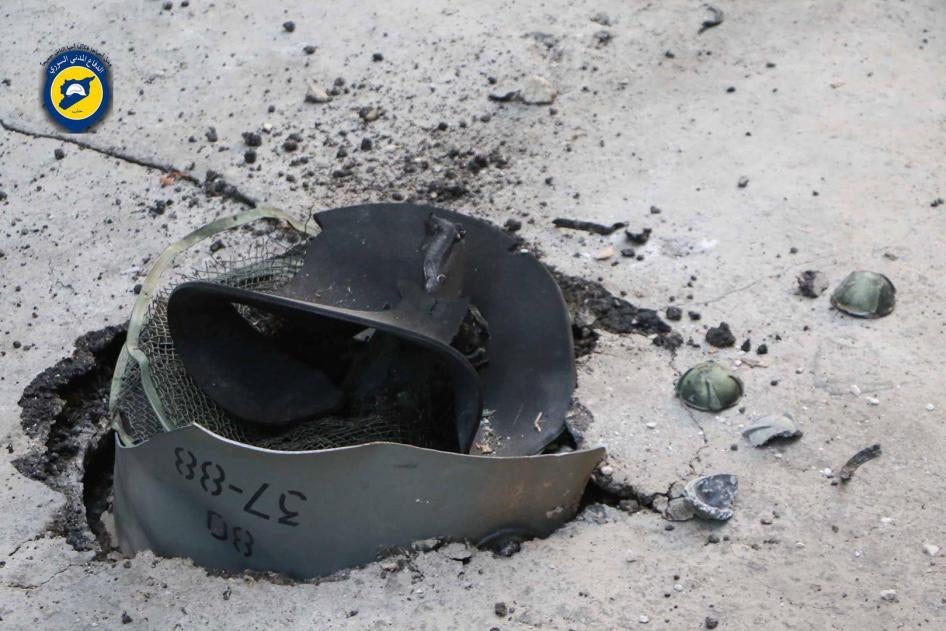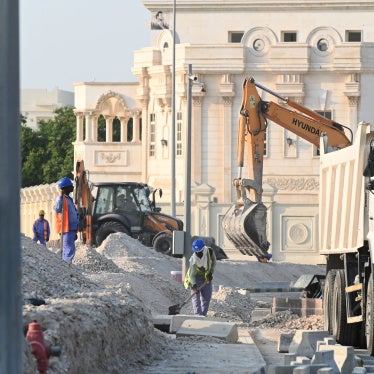(New York) – The Russian-Syrian coalition committed war crimes during a month-long aerial bombing campaign of opposition-controlled territory in Aleppo in September and October 2016.
The Violations Documentation Center, a Syrian civil monitoring organization, documented that the bombing campaign killed more than 440 civilians, including more than 90 children. Airstrikes often appeared to be recklessly indiscriminate, deliberately targeted at least one medical facility, and included the use of indiscriminate weapons such as cluster munitions and incendiary weapons. Satellite imagery that Human Rights Watch analyzed shows more than 950 new distinct impact sites consistent with the detonation of large high explosive bombs across the area during the month.
Local residents, media activists, and medical personnel told Human Rights Watch that the month-long bombardment was the most intense since the start of the conflict. One local journalist said: “Those were bloody days. It was a bloody month. Each day, Russian and Syrian airstrikes killed tens of people. It was the most terrible month since the beginning of the war.”
Those interviewed also said that the bombardment was particularly terrifying because of frequent use of bombs that they said they had not seen in the city of Aleppo before. Often referring to them as “bunker busting bombs,” local residents said that these weapons were capable of penetrating and demolishing entire multi-story concrete buildings, meaning it was no longer safe to hide in basements and underground shelters. Some of the attacks with the largest number of civilian casualties were from airstrikes that caused entire buildings to collapse.
The bombardment significantly affected several hospitals in eastern Aleppo. The Syrian-American Medical Society, which supports several hospitals in Aleppo, recorded 16 incidents of aerial bombardment affecting hospitals in the period. In some cases, aircraft dropped indiscriminate weapons such as incendiary weapons and cluster munitions near hospitals, causing them damage. In other cases, attacks struck the hospitals directly causing much greater damage.
Between September 28 and October 14, aircraft attacked the al-Sakhour Medical Center, a well-known hospital in Aleppo that also existed before the war, on at least four separate occasions, sometimes with multiple munitions. Photographs, video footage, and satellite imagery corroborate accounts of these attacks from witnesses reached by phone. The repeated attacks are strong evidence that the hospital was deliberately targeted, Human Rights Watch said. The hospital went out of service on October 1, because of the extensive damage from the strikes.
In the same period, attacks also struck search and rescue teams, including four centers operated by the Syria Civil Defense, a search and rescue group working in opposition areas.
During the month-long bombing campaign, Syrian military forces surrounded opposition-controlled eastern Aleppo. Although Syrian and Russian authorities declared that civilians and fighters could leave through designated corridors, very few did. Syrian and Russian authorities and armed opposition groups blamed each other for this. Whatever the reason, the Russian-Syrian coalition should have taken precautionary measures to avoid and minimize civilian casualties when attacking armed opposition groups, Human Rights Watch said.
The UN estimated that there were about 275,000 civilians and 8,000 fighters in eastern Aleppo at the time. Local residents said that most of these fighters were located near the frontlines and not in the residential areas in the interior of opposition-controlled territory.
On November 28, forces affiliated with the Syrian government advanced to take over key districts in east Aleppo held by armed opposition groups, including the neighborhood of al-Sakhour. Thousands of civilians have been forced to flee deeper into opposition-held territory, into government-controlled Aleppo, or into Kurdish-held areas like Sheikh Maqsoud.
Human Rights Watch has also documented armed opposition groups’ attacks against government-controlled western Aleppo.
Deliberate or reckless attacks against civilians and civilian objects, including hospitals, committed with criminal intent are war crimes. The laws of war require that parties to a conflict take constant care during military operations to spare the civilian population and to “take all feasible precautions” to avoid or minimize the incidental loss of civilian life and damage to civilian objects. UN Secretary-General Ban Ki-moon told the Security Council on September 28, that those using indiscriminate weapons in Aleppo “know they are committing war crimes.”
Seventy-three countries from all regions have endorsed a Canadian initiative seeking General Assembly action. The 223-member civil society coalition urged all UN member states to join the initiative.
“Inaction should not be an option,” the coalition said. “History will judge harshly those that fail to step up.”
The Bombing Campaign
Local residents, media activists, and medical personnel contacted by Human Rights Watch by phone described the month-long bombardment of Aleppo as the most intense since the start of the conflict. Using satellite imagery analysis, Human Rights Watch identified more than 950 new impact sites in Aleppo’s opposition-held neighborhoods between September 19 and October 18. The sites have damage signatures consistent with the detonation of large high explosive bombs. Damage sites were distributed across almost all neighborhoods under opposition control.
Russian and Syrian aircraft have used a variety of air-dropped, unguided munitions including blast, enhanced blast, fragmentation, and concrete-penetrating bombs, often of the 500-kilogram class – meaning that each can contain upwards of 200-kilograms of explosives. Cluster munitions and incendiary weapons have also been used in these airstrikes.
Human Rights Watch has not been able to conclusively identify the type of weapon used in attacks that collapsed entire buildings, often referred to by witnesses and in the media as “bunker busting bombs,” because of a lack of photographs and video footage of weapon remnants. However, witnesses citing tremors in the ground at the time of the attack and the extensive, but relatively contained, destruction of collapsed buildings are consistent with the use of concrete penetrating or demolition bombs with delayed-action fuzing like the BETAB or FAB-500-series unguided bombs.
The Russian-Syrian coalition has used both weapons in Syria. Russian military officials have said that they are using BETAB bombs against “terror” groups in Syria. Video footage published on YouTube show that the Syrian air force also used BETAB bombs before Russia joined the war. Video footage that Thiqa News Agency posted on YouTube on November 17, shows an unexploded FAB-500ShN demolition bomb that the news agency said was filmed in eastern Aleppo.
Civilian Casualties
The Violations Documentation Center (VDC), a local monitoring group, documented the killing of 446 civilians, including 91 children, in aerial attacks in eastern Aleppo between September 19 and October 18. VDC collected the names of 221 of the victims.
In several cases, local sources told Human Rights Watch that the actual casualty number was higher than those VDC recorded. For example, VDC documented that airstrikes killed 39 civilians in the Bustan al-Qasr district on October 11 and 12, while the local revolutionary council in Bustan al-Qasr said that airstrikes had killed 51 people on those days.
The Syrian Observatory for Human Rights, a Syrian monitoring group, said that aerial attacks killed 457 civilians, including 85 children, in the same period.
Al-Kallaseh, September 23
Two members of the local revolutionary council in al-Kallaseh and Bustan al-Qasr told Human Rights Watch in phone interviews that an airstrike destroyed a six-story residential building in al-Kallaseh neighborhood early in the morning of September 23.
Mohammed Nihad, one of the members, said that there were several aircraft in the sky that night, attacking several places:
I was asleep at home at the time. Perhaps 250 to 300 meters away from the place where the missile fell. I heard it fall and hit the ground. But the sound was unusual. It didn’t sound like a normal explosion. A small earthquake followed that even my relatives in Bustan al-Qasr felt. I arrived to the site of the attack 15 to 20 minutes later. We were surprised to see an entire building collapsed. Syria Civil Defense arrived but couldn’t find anyone wounded around the place. Everyone in the building died. We couldn’t rescue anyone. We felt helpless. The Syria Civil Defense kept working for eight days and managed to pull out many bodies.
Nihad said the bomb struck next to an adjacent gas station, burrowed into the ground, and exploded under the building, causing it to collapse shortly thereafter. Nihad also said that attacks struck the gas station itself and other residential buildings in the same period, but without civilian casualties.
The other member, Yasser, who didn’t want to give his full name, gave a similar account.
The two council members said that the attack killed 23 civilians. Nihad recounted 16 family members from four families, including eight children, that were killed in the attack. VDC documented the killing of 16 civilians, all unidentified, in aerial attacks in al-Kallaseh on September 23.
Nihad shared photographs from the impact site showing a pile of rubble from the collapsed building. Video footage posted on Syria Civil Defense’s YouTube channel shows a bulldozer clearing rubble at the same site. The photographs and video footage show damage consistent with the use of concrete-penetrating or demolition bombs.
The council members said that the building was residential with shops on the ground floor and that there were no armed groups nearby. Nihad said that armed opposition groups used to maintain a checkpoint near the gas station, but that it stopped operating in November 2015. The gas station has not operated for years, they said.
Al-Sha’ar, September 27
At about 4 p.m. on September 27, an aerial attack struck a five-story residential building in al-Sha’ar neighborhood, killing at least 24 civilians, including six children, according to VDC, Syria Civil Defense, and Karam al-Masri, a local photo journalist who spoke to Human Rights Watch by telephone from Aleppo.
Al-Masri said:
I saw the building completely razed to the ground. One child was wedged between the rubble… her blood was dripping. Her father was at work and arrived half an hour later and fell into tears. When they pulled the child out, he collapsed on the ground. He didn’t let the civil defense take her. He kept saying she’s asleep, she’s just asleep. But he couldn’t wake her up. It was heartbreaking.
Out of three families who had sought shelter in the building, only one child survived, he said. Al-Masri said that 25 people were killed. Syria Civil Defense reported that the attack killed 24 civilians and injured 15. VDC documented 24 civilian deaths in al-Sha’ar that day, including 6 children. VDC obtained the names of 10 of the victims.
Masri said that the building was on a street often referred to as “Cell-Phone Street” or “Clothes Street” because of its many shops. Al-Masri said that there was no armed presence near the impact site. Two other local journalists also said that there was no armed presence in al-Sha’ar neighborhood. They said that there were thousands of civilians, several important markets, and four hospitals in the neighborhood.
Photographs and video footage from the impact site shows a building with several floors collapsed onto one another while adjacent buildings remain relatively intact, damage consistent with the use of concrete-penetrating or demolition bombs. Graphic photographs and video footage also shows one body trapped between the collapsed floors and first responders working to retrieve the body.
Bustan al-Qasr, October 11
Airstrikes hit at least two residential buildings in the Bustan al-Qasr district on October 11. Ahmad K., a local resident, told Human Rights Watch by phone that he became worried when his mother-in-law did not answer the phone on October 11. He went to her house.
The building was razed to the ground; it just wasn’t there anymore. It was painful. You know a place and then it’s gone. I lived there when I first got married. But there was nothing anymore. The building was missing. It used to be five stories high with a five meters’ deep basement. The bomb squashed the whole building, burying whoever was inside.
Ahmad said that the Syria Civil Defense found his two brothers-in-law on day eight, and his mother-in-law and his sister-in-law on day ten. Ahmad said that the attack on his mother-in-law’s building killed 24 civilians from five families.
Ahmad said that another airstrike hit a residential building about 100 meters away at about the same time, killing about 30 civilians.
Al-Masri, the photo journalist, said that he was among the first to arrive at a site of an airstrike in Bustan al-Qasr on October 11:
Dust covered the place. I could hardly see. So I moved closer. And I looked up – the building was gone, it just wasn’t there. It had disappeared. I could hear people screaming under the rubble. People from other buildings tried to help. They called the Civil Defense. But it took them half an hour to arrive, there were many strikes on that day. When they arrived, the screaming from under the rubble had stopped. People suffocated and died.
Al-Masri said that 35 people had been killed in the building he saw that had collapsed. The local revolutionary council of al-Kallaseh and Bustan al-Qasr published a list of 51 people, including five children, killed by airstrikes in Bustan al-Qasr on October 11 and 12. VDC documented that airstrikes had killed 39 civilians, including four children, in Bustan al-Qasr on October 11, but none on October 12.
Ahmad described the area as a crowded residential neighborhood with several families living in each building. He said that there were no military bases or checkpoints in the area.
Marjeh, October 17
Early in the morning on October 17, aircraft dropped several bombs on a residential area in the Marjeh district, killing at least 13 civilians according to two local residents, Syria Civil Defense, VDC, and video footage posted on YouTube.
Zakaria Arab, a local resident of the Marjeh neighborhood, told Human Rights Watch by phone that he heard planes in the sky early in the morning on October 17. At about 5:15 a.m., he said, a bomb struck the neighboring house, which belonged to his father:
The house had collapsed. We spent three hours digging with our hands and using our own tools to pull out my father. There are no armed groups nearby. No soldiers. There’s a mosque, houses, shops, schools, clinics. This is a residential neighborhood.
Arab shared two videos of the rescue efforts of his father and a photograph of his father’s body.
Arab said that other bombs fell on his cousin’s house in the same neighborhood, killing 14, including two women and eight children. Syria Civil Defense reported that the attacks killed a 60-year-old man and 12 members of the Qabas family, including nine children, eight of them eight years old or younger. VDC documented that the aerial attacks in Marjeh on October 17 killed Terkey Arab and 12 members of the Qabas family, including nine children. Aleppo News Network posted video footage on YouTube showing the bodies of eight young children, which it said was from the October 17 attack on Marjeh.
Another local resident said: “The bombs turned the nearby streets into ashes. Stone turned into powder, into salt. The destruction was unimaginable. It’s like you know a place and then it’s suddenly ashes.” Qasioun News Agency posted video footage on YouTube showing completely destroyed houses next to a minaret.
Both local residents said that first responders were not able to reach the area for hours because the aircraft continued attacking.
Al-Sakhour Medical Center
Based on phone interviews with three hospital staff and witnesses, together with analysis of photographs, video footage, and satellite imagery, Human Rights Watch determined that airstrikes hit al-Sakhour Medical Center on at least four days between September 28 and October 14.
Ambulances bring injured civilians and injured fighters, but there is no military presence inside or outside the hospital. There are no weapons allowed into the hospital. We are very diligent about that.
September 28
Airstrikes hit the hospital at about 4 a.m. on September 28. Dr. Saad, a general surgeon at al-Sakhour hospital who did not want to reveal his full name, said that a munition, a barrel bomb he believed, struck the hospital’s wall, partially damaging the surgery ward and the intensive care unit. “The hospital was filled with dirt and dust, but thankfully there were no deaths or injuries,” he said in a phone interview with Human Rights Watch.
Photographs posted by the open source investigation group Bellingcat shows blast damage to the western part of the hospital compound.
A Syrian journalist from Australian NBC News took photographs of weapon remnants by the hospital after the attack. NBC News shared the photograph with Human Rights Watch, which identified the remnants as two air-dropped Russian-made ShOAB-0.5 fragmentation submunitions.
The hospital temporarily suspended its service because of the damage from the attack.
October 1
Hospital staff said that two aircrafts attacked the hospital again at about 11 a.m. on October 1. Over the next hour and a half, several strikes hit on or near the hospital.
They said that one strike hit a secondary facility used for non-critical patients across a narrow street from the hospital. The strike put the facility out of service. The strike also destroyed an ambulance, which can be seen in photographs and video footage of the aftermath. A second strike, five to seven minutes later, hit the street in front of the hospital where ambulances park, a nurse said. A third strike also hit near the front of the hospital.
When the attacks started, hospital staff and patients, about 200 people according to one doctor, sought shelter in the basement. Dr. Saad said:
Everyone panicked. It was terrible, really, really terrible. We had people in the clinics, women and children, the recovery wings were filled with patients, all civilians ... Women were crying and children were screaming. It’s as if death was falling upon us from the sky. We didn’t know what they might throw on us next. We almost suffocated from the smoke, the dirt, and the smell of gunpowder.
Ahmad Said, the surgery nurse, said:
Dust was everywhere. Patients were screaming: women, children, even men! We felt like it was the apocalypse. We didn’t know what to do. Do we hide? Do we try to rescue the people above us? We also knew that we were not safe now that they were using bunker busting bombs. We never imagined that we wouldn’t be safe underground.
Video footage that On-the-Ground News (OGN), an activist news organization, filmed next to the hospital and posted on YouTube shows the destroyed ambulance and a crater several meters wide in the asphalt outside the hospital entrance.
Dr. Saad also said that the aircraft dropped two cluster munitions on the hospital. “They kept exploding for thirty seconds,” he said.
Photographs and video footage support his account. Video footage from OGN shows remnants from a burster/igniter column from a cargo bomb and what appears to be remnants of PTAB-1M explosive submunitions. OGN shared unpublished video footage of the remnant with Human Rights Watch and confirmed that the footage was filmed near al-Sakhour hospital after the October 1 attack. Photographs of weapon remnants from the attack that a local journalist shared with Human Rights Watch conclusively show remnants from an air-dropped Soviet/Russian-made RBK-500 cluster bomb with PTAB-1M submunitions.
Medical staff and two journalists also said that they believed that aircraft dropped a bomb containing chlorine because they found yellow residue where the bomb had impacted. Although Human Rights Watch has documented the use of chlorine in attacks in Aleppo before, it was not able to confirm its use in this attack.
Mohamed Abu Rajab, the hospital’s head of administration, said in a phone interview that the attack on October 1, damaged the hospital building, and especially the laboratory. The attack damaged the intensive care unit again, the patients’ wing and destroyed generators, he said. Zouheir al-Shimale, a journalist who visited the hospital after the attack, gave a similar account. Dr. Abu Rajab said that the attacks killed at least two people and injured 10. The surgery nurse, Ahmed Said, said that he saw four dead bodies lying outside the hospital after the attack.
In a video published by the BBC, Dr. Abu Rajab walks through the hospital, showing the destruction, particularly to medical equipment, that the attack caused. Video footage also shows that an ambulance was destroyed in the attack.
October 3
At about 3:30 p.m. on October 3, an airstrike again hit the street in front of the hospital, near where one of the bombs fell on October 1.
Video from four closed circuit cameras from the hospital that Bellingcat posted on YouTube shows the moment of the airstrike, including one man being buried beneath the rubble. Dr. Saad said:
The hospital was out of service, but some of us had stayed to rehabilitate it, do maintenance work. The ground shook, the hospital got buried under the rubble. What was left is a huge crater, about 4 meters deep and 15 meters wide.
The attack killed at least three people working to repair the hospital and injured a nurse and an ambulance driver, hospital staff said.
October 14
On October 14, bombs – one doctor said four – hit again near the front entrance of the hospital, penetrating into the basement where pressurized gas canisters were stored. The canisters exploded and ignited fires. In the fire that followed the explosions, the hospital’s director and another staff member suffered serious burns, according to the surgery nurse.
Past Attacks
Local residents and media outlets have reported that attacks have hit al-Sakhour hospital several times also before the recent month-long bombardment campaign. In May 2015, the organization Doctors Without Borders reported that airstrikes had hit al-Sakhour hospital several times in a few days, forcing it to close. Video footage from a surveillance camera posted on YouTube appear to show that a bomb also hit the street in front of the hospital in August 2016.
Russian Denial
Russian military authorities have denied allegations that airstrikes hit al-Sakhour hospital. On October 25, General-Lieutenant S.F. Rudskoy held a briefing, a video recording of which was published on the Russian Defense Ministry’s YouTube channel. He presented two satellite images that he said were taken on September 24 and October 22 respectively, saying that there were no differences between the two images. He concluded that the accusations against the Russian air force were “plain forgeries.”
However, in addition to the witness statements, photographs, and video footage of the recent airstrikes, several sets of satellite imagery analyzed by Human Rights Watch clearly show that the hospital sustained significant damage between September 30 and October 10. The imagery shows a large crater in front of the hospital where bombs struck on October 1, 3, and 14. The imagery also shows the damage from the October 1 attack that destroyed the ambulance and put the outpatient facility out of service. The damage to the hospital is consistent with being hit by airstrikes.
Unlawful Use of Banned and Restricted Weapons
Incendiary Weapons
Incendiary weapons produce heat and fire through the chemical reaction of a flammable substance, causing excruciatingly painful burns that are difficult to treat. The weapons also start fires that are hard to extinguish, destroying civilian objects and infrastructure.
Protocol III of the Convention on Conventional Weapons (CCW) bans the use of air-delivered incendiary weapons in areas with “concentrations of civilians.” Russia is a party to the incendiary weapons protocol and has acknowledged the “significant humanitarian damage” caused by incendiary weapons in Syria, which it attributed to “improper use,” in a November 2015 letter to Human Rights Watch.
Syria has not joined Protocol III, but is still bound by customary international humanitarian law, which bans the use of methods or means of combat that cannot be directed at a specific military objective. The incendiary weapons used in eastern Aleppo spread incendiary submunitions over a large area.
Human Rights Watch has documented previous use of incendiary weapons in Syria, including in areas with concentration of civilians.
Al-Sha’ar, September 30
At about 5:30 to 6 p.m. on September 30, incendiary weapons struck al-Sha’ar neighborhood, setting several buildings on fire, including three hospitals.
A journalist for OGN who was in al-Sha’ar during the attack told Human Rights Watch by phone:
I saw an airplane flying above. I then saw a puff of smoke in the air and several objects flying in different directions. One of those objects fell behind me. It was a coal-like substance in flames. It burned for 5 or 6 minutes, then turned to ash, glowing, like when a fire dies.
The journalist shared footage of the burning object and other remnants, which Human Rights Watch identified as air-dropped RBK-500 ZAB-2.5SM incendiary bomb.
Three staff members at two of the hospitals, whom Human Rights Watch interviewed by phone, said that munitions had hit the hospitals, setting them on fire. Dr. Abu al-Motassim said: “One of the strikes landed on top of the hospital and another at the end of our street. There was intense fear, chaos, and panic. We tried to put out the fires by using dirt.”
Dr. Abu al-Motassim shared photographs and video footage that he took with Human Rights Watch, which showed small, intensely burning fires, hallmark signatures of incendiary weapons. The two other hospital staff members shared photographs and video footage taken by their colleagues showing similar fires.
The journalists and the medical staff said that nobody was killed or injured in the attack, but several buildings, including the three hospitals, were damaged.
Human Rights Watch has not been able to establish whether the hospitals were the intended target of the attack, but attacks struck all three hospitals in the past, including on July 23, 2016.
Other Attacks Using Incendiary Weapons
Local media activists and first responders reported on social media numerous attacks using incendiary weapons during the month-long bombing. For the following dates and neighborhoods, Human Rights Watch reviewed photographs or video footage published on the internet that appear to show the use of incendiary weapons:
|
Date |
Neighborhood |
Visual confirmation |
|
25/09/16 |
Al-Mashhad |
|
|
23/09/16 |
Al-Asileh |
|
|
22/09/16 |
Al-Kallaseh, Bustan al-Qasr |
Cluster Munitions
Cluster munitions can be fired by artillery and rocket systems or dropped by aircraft. They typically explode in the air and send multiple – sometimes hundreds – of smaller bomblets or submunitions over an area the size of a football field. Submunitions often fail to explode on initial impact, leaving duds that act like landmines and pose a threat until cleared and destroyed.
A total of 119 countries have banned cluster munitions because of their widespread, indiscriminate effect at the time of use, and the long-lasting danger to civilians. Although Russia and Syria are not members of the Convention on Cluster Munitions, they are still bound by customary international humanitarian law, which prohibits indiscriminate attacks.
Reviewing photographs and video footage, Human Rights Watch identified two types of air-dropped Russian-made cluster munitions used during the month-long bombing campaign: RBK-500 cluster bomb with ShOAB-0.5 submunitions and RBK-500 cluster bomb with PTAB-1M submunitions.
In several attacks, including two attacks of the attacks on al-Sakhour Medical Center, aircraft dropped cluster munitions together with other types of munitions.
Human Rights Watch has documented widespread previous use of cluster munitions in Syria.
Al-Kallaseh and Bustan al-Qasr, September 24
On September 24, cluster munitions were used in attacks on al-Kallaseh and the Bustan al-Qasr neighborhoods, according to a witness, the local revolutionary council, and photographs and video footage of the remnants.
Al-Masri, the journalist, who was in al-Kallaseh that day, told Human Rights Watch by phone that one cluster bomb fell on the neighborhood in the morning, but failed to disperse the submunitions. He took photos of the cluster bomb stuck in the ground, two of which he posted on his Twitter account. Syria Civil Defense posted video footage and a photograph of the same remnants. Human Rights Watch identified them as remnants of a RBK-500 cluster bomb with ShOAB-0.5 submunitions.
At about 11 a.m. or 12 p.m., another cluster munition struck Bustan al-Qasr, a neighborhood adjacent to al-Kallaseh. Al-Masri arrived at the impact site shortly after the attack and said that the attack had struck and area where hundreds of people had lined up near a yogurt store.
People were lying on the ground. Blood was mixed with yogurt, with bread. Blood was flowing for 15 meters. It was a river of blood. It was unbelievable. Wherever you went, you’d find someone injured. No one escaped, even people who hid in buildings. I saw with my own two eyes at least 60 injured civilians at the hospital. Hospitals were so crowded they couldn’t handle all the injuries. Honestly, that was the worst day for me in 2016. A massacre!
Human Rights Watch has not been able to establish a final casualty count. Al-Masri said that the attack killed 30 people and injured more than 200. The local council of al-Kallaseh and Bustan al-Qasr neighborhoods said in a post on Facebook that the attack killed 15 people and wounded dozens. The Aleppo Media Center posted graphic video footage of wounded receiving treatment at a medical facility, the description of which said that the attack killed 13 and wounded 75. VDC documented the names of five civilians killed in airstrikes in Bustan al-Qasr on September 24, including one child, but Human Rights Watch was not able to establish whether the five were killed in the cluster munition attack.
Salaheddin, September 25
Between 2 and 3 p.m. on September 25, aircraft dropped cluster munitions near the Seif al-Dawla roundabout in the Salaheddin district in Aleppo. Salaheddin is a residential district near the frontlines, according to local residents.
Zouheir al-Shimale, a local journalist, told Human Rights Watch in an interview by telephone that four civilians were killed in the attack. “I knew those who were killed,” he said. “One has a shop nearby, another runs a generator. The two others also live nearby.” Another journalist confirmed to Human Rights Watch that his friend’s father had been killed in the attack. Syria Civil Defense reported on their Facebook page that cluster munitions had killed three civilians and injured 20.
Syria Civil Defense posted graphic video footage of wounded being carried from the impact site and being treated in a medical facility, and footage of extinguishing fire in a bus. Thiqa News Agency posted video footage from the scene, showing the bus on fire.
Al-Shimale shared with Human Rights Watch a photograph he took of a cluster munition remnant that he also posted on Twitter. While the photograph shows the cluster bomb container, Human Rights Watch has not been able to determine the type of submunition used in the attack.
